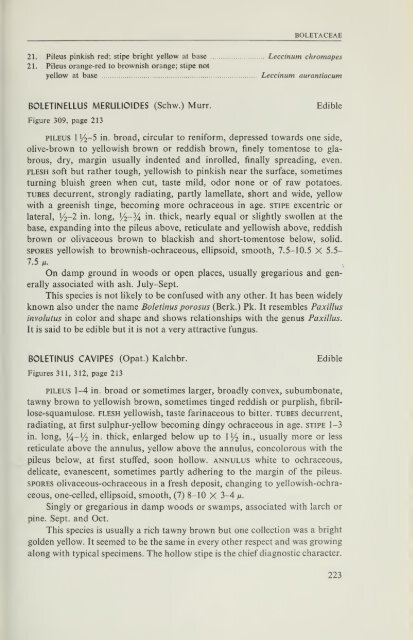Create successful ePaper yourself
Turn your PDF publications into a flip-book with our unique Google optimized e-Paper software.
BOLETACEAE<br />
21. Pileus pinkish red; stipe bright yellow at base Leccinum chromapes<br />
21. Pileus orange-red to brownish orange; stipe not<br />
yellow at base Leccinum aurantiacum<br />
BOLETINELLUS MERULIOIDES (Schw.) Murr. Edible<br />
Figure 309, page 213<br />
PILEUS 1 1/2-5 in. broad, circular to reniform, depressed towards one side,<br />
olive-brown to yellowish brown or reddish brown, finely tomentose to gla-<br />
brous, dry, margin usually indented and inrolled, finally spreading, even.<br />
FLESH soft but rather tough, yellowish to pinkish near the surface, sometimes<br />
turning bluish green when cut, taste mild, odor none or of raw potatoes.<br />
TUBES decurrent, strongly radiating, partly lamellate, short and wide, yellow<br />
with a greenish tinge, becoming more ochraceous in age. stipe excentric or<br />
lateral, 1/2-2 in. long, i/^-% in. thick, nearly equal or slightly swollen at the<br />
base, expanding into the pileus above, reticulate and yellowish above, reddish<br />
brown or olivaceous brown to blackish and short-tomentose below, solid.<br />
spores yellowish to brownish-ochraceous, eUipsoid, smooth, 7.5-10.5 X 5.5-<br />
7.5 M.<br />
On damp ground in woods or open places, usually gregarious and gen-<br />
erally associated with ash. July-Sept.<br />
This species is not likely to be confused with any other. It has been widely<br />
known also under the name Boletinus porosus (Berk.) Pk. It resembles Paxillus<br />
involutus in color and shape and shows relationships with the genus Paxillus.<br />
It is said to be edible but it is not a very attractive fungus.<br />
BOLETINUS CAVIPES (Opat.) Kalchbr. Edible<br />
Figures 311, 312, page 213<br />
PILEUS 1-4 in. broad or sometimes larger, broadly convex, subumbonate,<br />
tawny brown to yellowish brown, sometimes tinged reddish or purphsh, fibril-<br />
lose-squamulose. flesh yellowish, taste farinaceous to bitter, tubes decurrent,<br />
radiating, at first sulphur-yellow becoming dingy ochraceous in age. stipe 1-3<br />
in. long, 54-1/2 in. thick, enlarged below up to 1 1/2 in., usually more or less<br />
reticulate above the annulus, yellow above the annulus, concolorous with the<br />
pileus below, at first stuffed, soon hollow, annulus white to ochraceous,<br />
dehcate, evanescent, sometimes partly adhering to the margin of the pileus.<br />
spores olivaceous-ochraceous in a fresh deposit, changing to yellowish-ochra-<br />
ceous, one-celled, elHpsoid, smooth, (7) 8-10 X 3-4 m-<br />
Singly or gregarious in damp woods or swamps, associated with larch or<br />
pine. Sept. and Oct.<br />
This species is usually a rich tawny brown but one collection was a bright<br />
golden yellow. It seemed to be the same in every other respect and was growing<br />
along with typical specimens. The hollow stipe is the chief diagnostic character.<br />
223

















